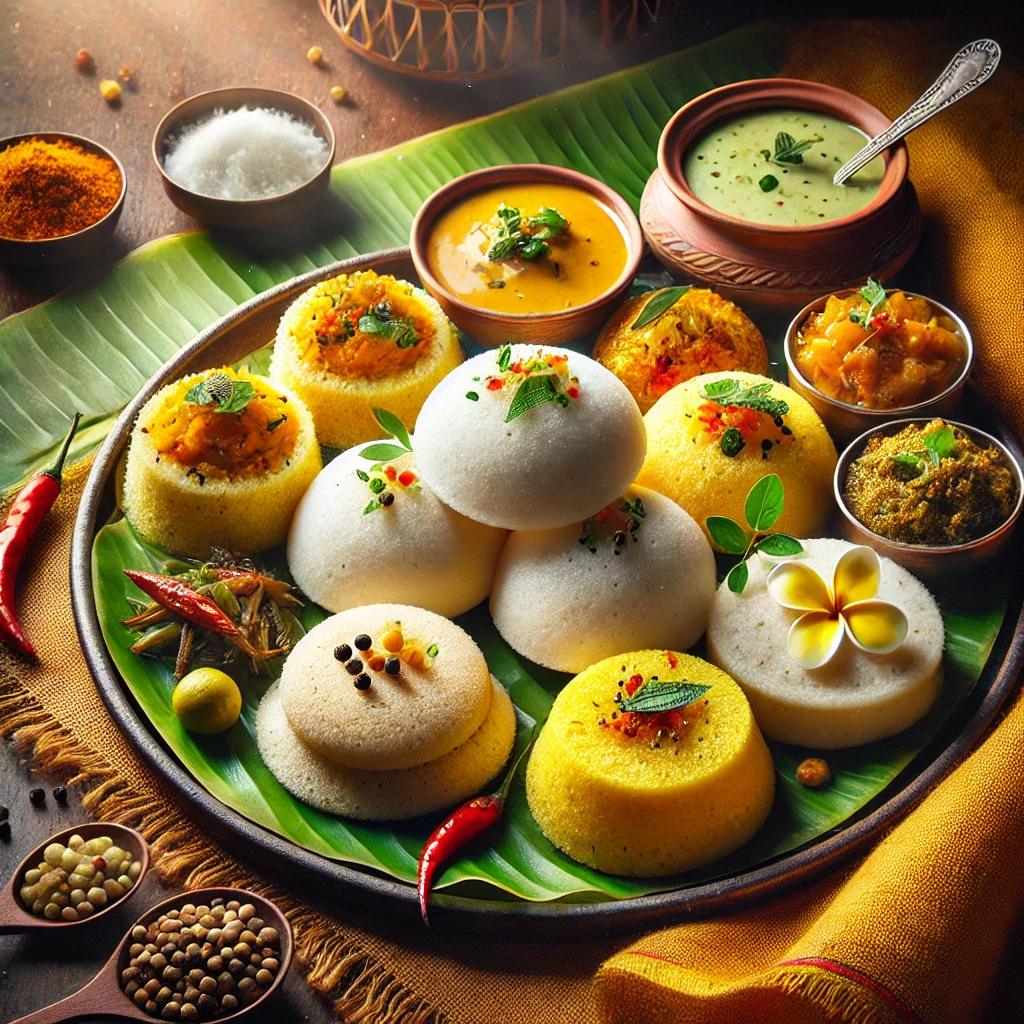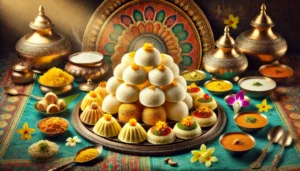
How to prepare idli and dhokla
Sacred Fermented Foods: Idli, Dhokla, and More
Fermented foods are an integral part of traditional Indian cuisine, celebrated for their rich flavors, health benefits, and symbolic significance in our culinary heritage. These dishes, like idli, dosa, dhokla, kanji, and pickles, not only reflect the wisdom of our ancestors but also hold spiritual and cultural importance. Their preparation techniques, passed down for generations, encapsulate the harmony between nature, science, and the human body.
In this article, we explore some of India’s most beloved fermented foods, their ancient preparation methods, and the incredible health benefits they bring.
The Timeless Practice of Fermentation
Fermentation, the natural process of transforming food through microorganisms, is among humanity’s earliest food preservation techniques. Archeological evidence suggests that fermented foods have been part of human diets for over 7,000 years. In India, this technique wasn’t merely practical; it was rooted in spirituality and Ayurveda.
According to Vedic traditions, food is seen as a carrier of prana (life force). The act of preparing food, especially fermented dishes, was treated with sanctity and mindfulness. Fermentation was believed to enhance the sattvic (pure) qualities of food, making it nourishing for both body and mind.
Additionally, fermentation was seen as a reflection of the cosmic process of transformation: just as grains and lentils are broken down to create lighter, more nourishing dishes, the human soul evolves through transformation and refinement.
Table of Contents
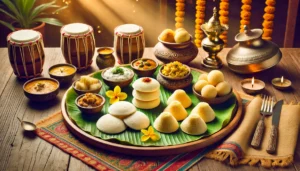
How to prepare idli and dhokla
Celebrated Fermented Foods of India
- Idli and Dosa: The Quintessential South Indian Staples
The humble idli and crispy dosa are cornerstones of South Indian cuisine, made from a batter of fermented rice and urad dal. This batter, left to ferment overnight, becomes a probiotic powerhouse by morning. Steamed idlis and griddled dosas are paired with sambar and chutneys to form a wholesome, easily digestible meal.
Ancient Preparation:
The traditional grinding of batter was done on a stone grinder to retain the nutrients.
Water from natural wells was often used for the batter to encourage wild fermentation.
The process was guided by natural temperature changes, often tied to the lunar cycles for auspicious preparation.
Health Benefits:
Rich in B vitamins (produced during fermentation), essential for energy metabolism.
Provides complete protein when combined with sambar or chutneys.
Easy on the stomach due to the breakdown of starches and proteins during fermentation.
- Dhokla: Gujarat’s Fermented Gem
Light, spongy, and tangy, dhokla is made from a batter of fermented rice and chickpea flour. Traditionally, the batter was left to ferment naturally in warm conditions, making this dish both nutritious and full of flavor.
Ancient Preparation:
Instead of instant leavening agents, fermentation was entirely natural.
Banana leaves were sometimes used to steam the dhokla, infusing it with subtle earthy flavors.
Ingredients like hing (asafoetida) and ginger were added for their digestive properties.
Health Benefits:
Improves gut microbiota, thanks to the lactic acid bacteria.
A source of slow-digesting carbs, ideal for sustained energy.
Steaming instead of frying preserves nutrients and keeps it low in fat.
- Kanji: India’s Probiotic Elixir
A traditional North Indian drink, kanji is made by fermenting black carrots, mustard seeds, and water. This tangy, spiced beverage is consumed during winter and is known for its cooling and digestive properties.
Ancient Preparation:
Large earthen pots were used for fermentation, allowing natural bacteria to thrive.
The process was initiated under the sun, leveraging natural warmth to encourage fermentation.
Families prepared kanji communally, adding to its cultural significance.
Health Benefits:
Packed with probiotics to improve digestion and nutrient absorption.
High in antioxidants, supporting detoxification.
Boosts immunity through the fermentation-enhanced bioavailability of nutrients.
- Pickles (Achar): A Spiced Legacy
No Indian meal is complete without a dollop of spicy, tangy pickle. From mangoes to lemons, chillies to gooseberries, almost any fruit or vegetable can be transformed into a delightful pickle through fermentation.
Ancient Preparation:
Pickles were fermented in clay jars under the sun for weeks, a process that enriched them with probiotics.
Oil, salt, and natural spices acted as preservatives and flavor enhancers.
Ayurveda placed high importance on achar, often recommending specific varieties for different doshas (body constitutions).
Health Benefits:
Encourages growth of healthy gut bacteria.
Rich in vitamin C and other antioxidants.
Acts as a digestive aid due to spices like turmeric and fenugreek.
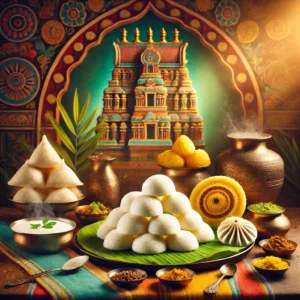
How to prepare idli and dhokla
Why Fermented Foods Are a Health Treasure
Gut Health: Fermented foods are a natural source of probiotics that enhance gut microbiota, aiding digestion, reducing inflammation, and boosting immunity.
Enhanced Nutrient Absorption: Fermentation breaks down anti-nutrients like phytates, making minerals like iron, zinc, and calcium more bioavailable.
Rich in Enzymes: These aid in digestion and reduce the burden on the digestive system.
Natural Detoxification: The acids produced during fermentation bind to toxins, helping eliminate them from the body.
Boosts Mood: Fermented foods have been linked to better mental health through the gut-brain axis.
Cultural and Spiritual Significance
In Indian households, food preparation was a sacred act. The fermentation process, requiring time and patience, was seen as a practice of mindfulness. Families believed that the positive energy and devotion of the cook would influence the quality of the food.
Even today, festivals and rituals are incomplete without fermented dishes. Dahi (curd), for instance, is considered auspicious and offered to deities. Similarly, fermented batters for dishes like idli and dosa are often prepared during specific lunar phases to enhance their vibrational energy.
Reviving Ancient Traditions
While modern convenience has introduced packaged and instant mixes, there is a growing awareness of the importance of traditional, slow fermentation techniques. By reviving these methods, we can reconnect with our roots, improve our health, and preserve cultural wisdom for future generations.
Fermented foods like idli, dhokla, and kanji are not just meals—they’re a testament to the ingenuity and spiritual depth of ancient Indian culture. Let us honor this heritage by making these sacred foods a part of our daily lives.
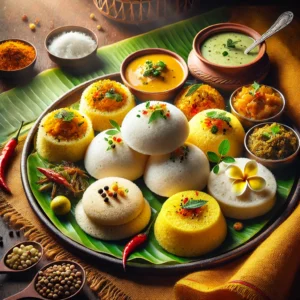
How to prepare idli and dhokla
FAQs on “Idli, Dhokla, and More: The Sacred Fermented Foods of India”
- What are fermented foods?
Fermented foods are foods that have undergone fermentation, a process in which natural microorganisms such as bacteria, yeast, or molds break down starches, sugars, or proteins into simpler compounds. This not only enhances the taste but also makes the food more nutritious and easier to digest. Examples include yogurt, kefir, kimchi, and sauerkraut, along with traditional Indian dishes like idli and dhokla.
- Why are idli and dhokla considered fermented foods?
Idli and dhokla are made from fermented batters. In the case of idli, a mixture of soaked rice and urad dal (split black gram) is ground, and after fermentation, the batter is steamed to produce soft, spongy cakes. Similarly, dhokla is made by fermenting a batter of gram flour (besan) with yogurt or other sour agents, and then steaming it. The fermentation process allows these foods to become light, airy, and flavorful while boosting their nutritional content.
- What are the health benefits of eating fermented foods like idli and dhokla?
Fermented foods are rich in probiotics, beneficial bacteria that support gut health by improving digestion and enhancing nutrient absorption. They also help in balancing the gut microbiome, which can contribute to stronger immunity. Fermented foods like idli and dhokla are typically lower in glycemic index, making them easier on blood sugar levels. Additionally, the fermentation process breaks down complex proteins and fibers, making them more digestible and potentially reducing issues like bloating or discomfort.
- How does fermentation impact the taste of these foods?
Fermentation imparts a mild tangy flavor to fermented foods. In idli, this sourness is subtle and enhances its natural flavors, making the texture light and fluffy. Similarly, dhokla’s fermentation gives it a slightly sour yet savory flavor that contrasts beautifully with its soft, spongy texture. The process also improves the digestibility of these foods, as fermentation breaks down starches and proteins into simpler forms.
- Are there any other popular fermented foods in Indian cuisine?
Yes, Indian cuisine features a wide range of fermented foods beyond idli and dhokla. Some examples include:
Dosa: A crispy pancake made from a fermented rice and urad dal batter.
Appam: A type of fermented rice pancake, often served with coconut milk.
Kanji: A fermented drink made with mustard seeds, water, and sometimes vegetables, commonly consumed in parts of North India during winter.
Achar (Pickles): Various fruits and vegetables that are fermented with spices and oils, often used as condiments.
Lassi: A fermented yogurt drink, often flavored with fruits or spices.
Puran Poli: A sweet flatbread made from fermented dough, traditionally served during festivals.
- How is the fermentation process traditionally done for idli and dhokla?
Idli: Traditional preparation of idli involves soaking rice and urad dal for several hours (or overnight), followed by grinding them into a smooth batter. The batter is left to ferment in a warm environment for 8-12 hours. The natural fermentation process is crucial for achieving the characteristic fluffiness and light texture of idlis.
Dhokla: For dhokla, gram flour (besan) is mixed with yogurt, water, and spices, and allowed to ferment for a few hours. Once fermented, the batter is steamed to create a light, spongy texture. The fermentation process is important to develop the signature tang and soft consistency of dhokla.
- Can fermentation happen in all climates?
Fermentation thrives in warm environments, where the microbial activity that causes fermentation is most active. In cooler climates, fermentation may take longer, and the batter may need to be kept in a warm place, such as near a stove or in an oven with the light on. Some people also use fermentation chambers or slow cookers designed to maintain a consistent warm temperature for optimal fermentation.
- Are fermented foods like idli and dhokla suitable for everyone?
Fermented foods are generally safe for most people and can be enjoyed as part of a balanced diet. However, individuals with food sensitivities, such as gluten intolerance or soy allergies, should ensure they choose the appropriate ingredients. For example, idli batter is naturally gluten-free, but variations using wheat flour might exist. Additionally, some individuals with digestive conditions may find fermented foods easier to digest than non-fermented alternatives, while others may need to start with smaller portions.
- How are fermented foods linked to ancient traditions in India?
Fermentation is an age-old technique, deeply embedded in India’s culinary and spiritual traditions. In ancient times, fermentation was not just a method for preserving food but was also considered a process that could enhance the food’s purity and health benefits. In Ayurvedic medicine, fermented foods are believed to have balancing properties for the digestive system. Moreover, fermented foods like idli and dosa are traditionally prepared during auspicious occasions, festivals, and rituals, symbolizing nourishment and spiritual well-being.
- Can modern techniques replace traditional fermentation?
While modern methods such as adding baking soda, yeast, or chemical leavening agents can speed up the fermentation process, traditional fermentation remains the most effective way to ensure the authenticity, texture, and nutritional benefits of these foods. The slow, natural fermentation process enhances the flavors and allows beneficial probiotics to develop, which cannot be replicated by artificial means.
- What role do fermented foods play in Indian festivals and rituals?
Fermented foods hold cultural significance in many Indian festivals and rituals. Dishes like idli, dosa, and dhokla are often prepared during important occasions, such as weddings, religious ceremonies, and regional festivals like Pongal or Diwali. They are considered symbols of purity and are often offered as part of religious rituals. The act of preparing and sharing fermented foods is seen as an expression of gratitude and reverence in many communities.
- How can I experiment with fermented foods at home?
To start experimenting with fermented foods, begin with simple recipes like idli or dosa, which require minimal ingredients. Ensure that the batter is given enough time to ferment properly, typically 8-12 hours, depending on the ambient temperature. You can also experiment with different flours (e.g., rice, millet, chickpea) or add spices to vary the flavor profile. As you become more confident, you can explore making other fermented dishes such as appam, kanji, or even kefir.
- How can I store leftover fermented batter?
Leftover fermented batter can be stored in an airtight container in the refrigerator for up to 2-3 days. Ensure that the batter is properly covered to prevent contamination. It may lose some of its fermentation power over time, so allow it to come to room temperature before using it for making idli or dosa.
- Is it possible to make fermented foods in a gluten-free version?
Yes, it is possible to make gluten-free fermented foods. For instance, traditional idli and dosa are made with rice and urad dal, which are naturally gluten-free. You can also try experimenting with other gluten-free grains like millet, sorghum, or buckwheat. Just ensure that the ingredients used are free from gluten to make the dish entirely gluten-free.
- What other innovative fermented dishes can I try?
While idli, dhokla, and dosa are some of the most popular fermented foods in India, you can try making fermented snacks like vada, or fermented rice preparations like pongal and khichdi. For a modern twist, try making fermented plant-based dishes like tempeh or fermented vegetable pickles. You can also explore fermenting fruits to make probiotic-rich drinks or smoothies.
Summary
“Idli, Dhokla, and More: The Sacred Fermented Foods of India” explores the deep cultural and spiritual significance of traditional fermented foods in India. It highlights how foods like idli and dhokla, which are staples in South and Western India, are not just culinary delights but also carry health benefits rooted in ancient wisdom. The process of fermentation is shown to enhance the digestibility and nutritional value of these foods, while also connecting them to spiritual practices. This article delves into the science behind fermentation, its role in Indian rituals, and its connection to the philosophy of mindfulness and purity in food preparation, showing that these dishes are more than just meals—they are part of India’s sacred food culture.
Related Articles
- Restful Nights: Ayurvedic Remedies and Traditional Indian Practices to Overcome Insomnia and Late-Night Habits
- The Tridevi: Lakshmi, Saraswati, and Parvati – Their Roles and Powers
- “Divine Creatures of Ancient Indian Scriptures: Exploring the Role of Animals in the Vedas, Puranas, and Mahabharata”
- Nature and Spirituality: Exploring the Sacred Essence of the Himalayas, Ganga, and Other Natural Wonders”
- “Reviving the Gurukul System: Relevance and Lessons for Modern Education”
- “Exploring Greek and Indian Mythology: Similarities Between Greek and Indian Mythology “
- “Embracing Sattvic Living: Harmonizing Mind, Body, and Soul Through Food and Lifestyle”
- “Charity and Prosperity: Exploring the Concept of Daan and Its Financial Relevance in Modern Life”
- How to Build an Eco-Friendly Home Inspired by Vastu Shastra
- Comparison of Ancient and Modern Sports: How Traditional Sports Have Influenced Contemporary Games
- “Timeless Lessons from Ancient Tales: Linking Samudra Manthan and Ganga’s Descent to Modern Ecological Challenges”
- “Reviving Sanskrit: How AI is Preserving Ancient Languages for the Future”
- “Mathura: The Sacred Land of Lord Krishna’s Divine Leelas”
- Investing for Future Generations: Lessons from Indian Traditions on Legacy Building and Wealth Preservation
- “Ancient Indian Wisdom: Timeless Lessons for Tackling Today’s Climate Crisis”
- “Artificial Intelligence and Spirituality: Transforming Ancient Practices for the Modern World”
- “Gold and Real Estate in India: Timeless Assets Shaping Financial Strategies”
- Tradition Meets Innovation: The Evolution of Technology in Hindu Rituals
- End-of-World Myths: Exploring Kali Yuga in Hinduism and Ragnarök in Norse Mythology
- Garuda, Pegasus, and Dragons: The Universal Ties of Mythical Beasts Across Cultures
- “Ancient Vimanas: Mythical Flying Machines or Evidence of Advanced Technology?”
- Time Travel in Hindu Mythology: The Fascinating Tales of Kakudmi and King Raivata
- “Divine Feminine Power in Hindu Mythology: The Legends of Durga, Saraswati, and Lakshmi”
- “Divine Beings of Sanatan Dharma: The Spiritual Significance of Sacred Animals in Hinduism”
- “Symbolism in Mythological Art: Unlocking Hidden Meanings in Ancient Temple Carvings”
- “Exploring Technological Advancements in Ancient India and Civilizations: Vimana, Metallurgy, & Water Management systems”
- Unveiling the Mysteries: Ancient Temples of Sanatan Dharma , Mysterious Temples of India
- “The Scientific Knowledge of Sanatan Dharma: Ancient Wisdom Meets Modern Science”
- Ancient Indian Sports and Games: Celebrating a Legacy of Skill, Strength & Strategy”
- “Exploring the Cosmic Link: The Connection Between Astronomy and Vedic Astrology”
- The Power of Sanskrit: Unlocking the Divine Language of the Gods
- “The End of Kaliyuga: A Sanatan Insight into the World’s Final Chapter”
- Explore more articles on Prachin Sanatan Yuga.
How to prepare idli and dhokla How to prepare idli and dhokla How to prepare idli and dhokla How to prepare idli and dhokla How to prepare idli and dhokla How to prepare idli and dhokla How to prepare idli and dhokla How to prepare idli and dhokla How to prepare idli and dhokla How to prepare idli and dhokla How to prepare idli and dhokla How to prepare idli and dhokla
How to prepare idli and dhokla How to prepare idli and dhokla How to prepare idli and dhokla How to prepare idli and dhokla How to prepare idli and dhokla How to prepare idli and dhokla How to prepare idli and dhokla How to prepare idli and dhokla How to prepare idli and dhokla How to prepare idli and dhokla How to prepare idli and dhokla How to prepare idli and dhokla
How to prepare idli and dhokla How to prepare idli and dhokla How to prepare idli and dhokla How to prepare idli and dhokla How to prepare idli and dhokla How to prepare idli and dhokla How to prepare idli and dhokla How to prepare idli and dhokla How to prepare idli and dhokla How to prepare idli and dhokla How to prepare idli and dhokla How to prepare idli and dhokla
